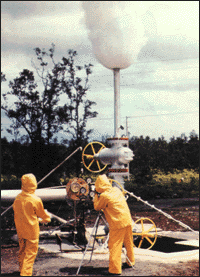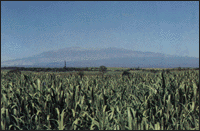Below: Sugar cane thrives in the fertile volcanic soils derived from products of past Hawaiian eruptions. Mauna Kea Volcano is seen in the distance. (Photograph by Robert I. Tilling.)
 �
�
Volcanic benefits
First of all, the Hawaiian Islands would not exist were it not for volcanic activity. Equally important, many factors that combine to make the islands an attractive place to live or visit depend directly or indirectly on the results of past and present eruptions.�
Hawaii's majestic volcanic mountains, beautiful beaches, and pleasant climate combine to make the islands a popular tourist attraction, which includes two heavily visited national parks. Haleakala National Park on Maui, founded in 1961, features the spectacularly eroded summit crater of 10,023 foot-high Haleakala Volcano, active as recently as about 1790. Hawaii Volcanoes National Park, created by Congress in 1916, contains the two currently active Hawaiian volcanoes, Mauna Loa and Kilauea. This park is one of the few places in the world where the processes and products of active volcanism can be viewed safely and comfortably by the nonspecialist and volcanologist alike. Indeed, millions of park visitors have experienced "live" the sights, sounds, and smells of volcanic eruptions and gained a firsthand appreciation of the phenomena that created and shaped these beautiful islands.
